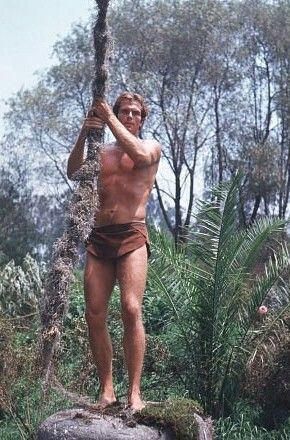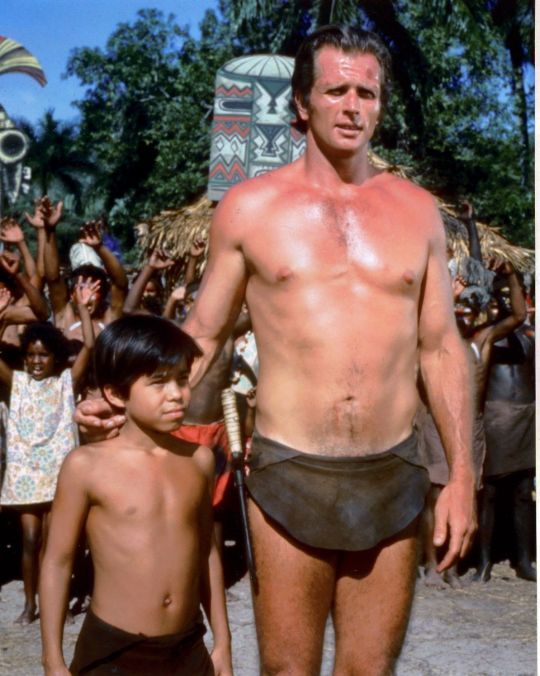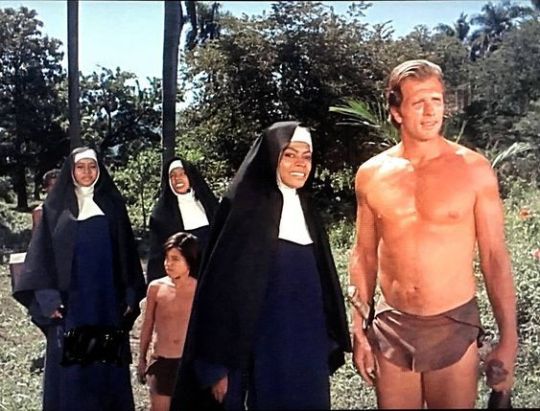#Sy Weintraub
Text

Ron Ely as Tarzan, and his chimp co-star Cheeta. Though they look like best friends, Ely suffered several bites from the little guy during the course of their two years working together.
For kids in the mid-to-late 1960s, Ron Ely WAS Tarzan.
Ely was the star of the 57-episode Tarzan TV series that ran two seasons, from 1966 to 1968, and then in near continual syndication for several years afterward.
The television series was executive produced by Sy Weintraub, who had been producing the Tarzan films since 1958. Weintraub was responsible for replacing the monosyllabic persona of Tarzan, made popular by the Johnny Weissmuller films of the 1930s and40s, with the educated, well-spoken character from Edgar Rice Burroughs' novels. True Trazan fans were delighted with this move, and I'm sure Burroughs himself would have been as well had he lived to see it (he died in 1950).

Tarzan about to demonstrate his vine swinging skills.
Weintraub also filmed his Tarzan movies on location, as opposed to in a studio with stock jungle footage. This made for some spectacular scenes, but it was rough on both the crew and his Tarzan actors: Gordon Scott, Jock Mahoney, and Mike Henry.
When he decided to make the Tarzan television series, Weintraub wanted Henry to continue in the role. However, Henry had made 3 Tarzan films back-to-back in 1965 and was physically exhausted. Thus the TV role eventually was awarded to Ely.
Like the Mike Henry films, the TV series was filmed in Brazil (first four episodes) and Mexico (the remainder of the series). This explains why the scenery, while lush and exotic, sometimes doesn't quite gel with images we'd seen of the African wilderness. It also explains why many of the extras appeared Latin as opposed to African.
Ely insisted on doing his own stunts for the series, a decision later on he would come to regret. He suffered more than two dozen serious injuries, which included two broken shoulders, lion bites, and several bites from his co-star, Cheeta the chimp. Allan Sherman, in an issue of the Tarzan comic book when it was published by DC, wrote an article and chart detailing all the injuries Ely incurred in the two years of production. Unfortunately, I have not been able to find the article to include here.
The one thing Ely could not do: the famous Tarzan yell. The production ended up using a recording of Johnny Weissmuller's version of the yell.
Ely's other co-star in the series was Jai, an orphaned boy (played by Manuel Padilla, Jr). Jai took the place of Boy, Tarzan's son from the Weissmuller films, and gave the ape man someone to protect and/or rescue every episode.

Manuel Padilla, Jr. as Jai, Tarzan's companion throughout the TV series, with Ron Ely as Tarzan.
As in Weintraub's films, the character of Jane was not present. Weintraub preferred a Tarzan who was a lone adventurer. The TV Tarzan was not a globetrotter like his film counterpart; his adventures were limited to a fictional African country.

The Tarzan series had several high profile guest stars including, believe it or not, Diana Ross and The Supremes: Cindy Birdsong, Mary Wilson, and Diana Ross as a trio of nuns.
The series got off to an uneven start, as the location shooting took longer than anticipated. Early episodes show signs of hasty, almost haphazard editing as they were assembled at a breakneck speed to meet NBC network's broadcasting schedule. Luckily, the production eventually found its footing, and things smoothed out quickly.



For a brief time Tarzan's TV adventures took over the cover spot on the Tarzan of the Apes comic book.
Warners Brothers has released the series on DVD back in 2012 and 2013. To my knowledge (which, admittedly, is faulty) it is not currently streaming or available on any cable channels.
#Tarzan#Tarzan of the Apes#Ron Ely#Cheeta#Jai#Manuel Padilla Jr.#Sy Weintraub#Edgar Rice Burroughs#Diana Ross and The Supremes
14 notes
·
View notes
Photo


Sy Weintraub took over as producer of the Tarzan franchise at MGM and added a boost to the series. Jock Mahoney was the new Tarzan and he would work with Weintraub in two movies.
“Tarzan Goes to India” (1962)
“Tarzan’s Three Challenges” (1963) Filmed in Thailand
These are two very good movies but Mahoney became very ill in Thailand and the role was turned over to Mike Henry.
17 notes
·
View notes
Video
Posted @withregram • @brucelee 🐉✍🏼📸From the Archive #70: Bruce's Daytimers Bruce Lee lived in a pre-internet and cell phone age and so he carried with him small daytimer calendar books in which he recorded his appointments. But, being Bruce Lee, he used these books for much more than that. He oftentimes recorded workouts and motivational messages for himself. Here is a glimpse into some of those daytimers and the types of messages, people, places, notes and ideas that he used them for! 1. Bruce Lee writing intently 2. Some of Bruce Lee’s daytimers 3. June 1967 – Workout and haircut in Chinatown, Lunch with William Dozier (cancelled), Linda and Brandon head to Seattle, great dane Bo has a vet appt 4. January 1968 – very detailed workout tracking 5. September 1968 – Lew Alcindor, Stirling Siliphant, Steve McQueen, a jeet kune do workout 6. December 1968 – Look to This Day poem by Kalidasa 7. February 1969 – Sy Weintraub, Coburn, McQueen, Porsche maintenance, workouts, dedicated time to read and study 8. August 31, 1968 – Jim Coburn’s birthday and students at the house for training 9. November 1969 – birthday party at home with party guests 10. 1969 – motivational phrases and ideas . #brucelee #bruce #fromthearchive #bruceleearchive #JeetKuneDo #jkd #SteveMcQueen #JimCoburn #KungFu #MartialArts https://www.instagram.com/p/CO1dLgEBfI2/?igshid=245zmyv5yzd7
#70#brucelee#bruce#fromthearchive#bruceleearchive#jeetkunedo#jkd#stevemcqueen#jimcoburn#kungfu#martialarts
0 notes
Text
'Tarzan and The Valley of Gold' Book Review By Ron Fortier
New Post has been published on https://esonetwork.com/tarzan-and-the-valley-of-gold-book-review-by-ron-fortier/
'Tarzan and The Valley of Gold' Book Review By Ron Fortier

TARZAN AND THE VALLEY OF GOLD
By Fritz Leiber
From a Screenplay by Clair Huffaker
ERB, Inc.
320 pages
Clair Huffaker was one of the finest American writers to ever work in Hollywood. In 1965 he was hired by producer Sy Weintraub to write a new Tarzan film which would feature a modern sophisticated version of Edgar Rice Burroughs’s classic hero. It would be the first of three to star former football pro Mick Henry as the new, suave and debonair Ape Man. “Tarzan and the Valley of Gold” was released in the summer of 1966.
The plot has Tarzan flying to Mexico in answer to a summons from an old friend who works for the government. A treacherous villain, whose hobby is blowing people up, has located the whereabouts of a lost civilization and is going there at the head of his own private mercenary army. Tarzan’s job is to stop him and save the lost city of gold. Eschewing the previous Tarzan movies, Weintraub and Huffaker purposely ignored any references to Jane, Boy or any other trappings that had been added over the years. Trappings that had turned Burroughs savage champion into a middle-aged, family man as exciting as a bowl of porridge.
Henry not only looked the part as envisioned by readers, but this Tarzan was also intelligent, multi-lingual and resourceful. The movie moves at a fast clip and the action never stops. It remains one of our favorites. It wasn’t till years later that we discovered sci-fi writer Fritz Leiber had written a paperback novelization of the screenplay. It was the first authorized Tarzan novel by an author other Burroughs and was officially listed as the 25th book in the series. With only one printing, the book soon disappeared and became a unique literary treasure sought by many fans over the years. Now ERB, Inc. has produced a beautiful hardcover edition which features a gorgeous cover by Richard Hescox and three black and white interior illustrations by Douglas Klauba.
Known for his creation of the sword and sorcery characters Fathrd and Gray Mouser, Leiber took Huffaker’s lean tale and turned it into a full blown, detailed novel that in the end had very little resemblance to the actual movie. In the book most of the story takes place in the jungle of Brazil and is purposely adjusted to the Tarzan canon as written by Burroughs. Thus there are footnotes galore referring to past Burroughs books and the missus is mentioned, though never by name. Leiber even alludes to his hero’s supposed longevity as having to do with the supernatural.
Where Leiber’s story shines is his complete characterizations of all the principles from Tarzan to the villain Vinaro. No longer cookie-cutter Bond-like figures, each of them is fully realized adding great depth to the adventure. We’re even given Tarzan’s personal self-refection as he continually struggles with his duel natures; one civilized and the other a primitive beast. All in all, the book is truly something unique and a wonderful read. Thank you ERB, Inc. for rescuing it from the obscurity and giving all us Tarzan fans this beautiful edition.
0 notes